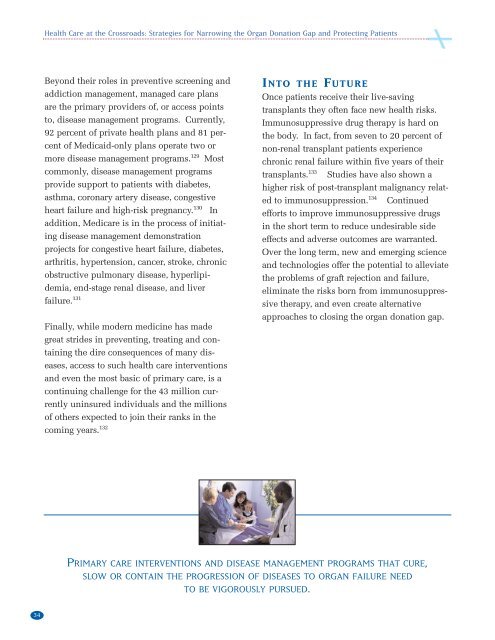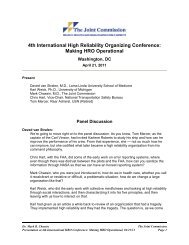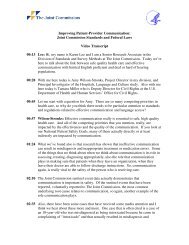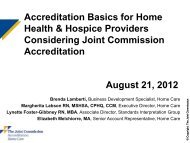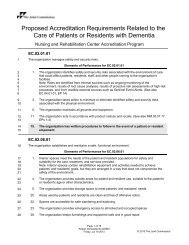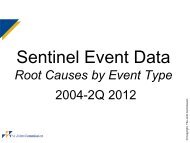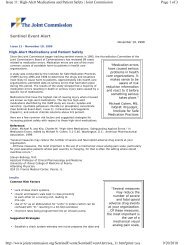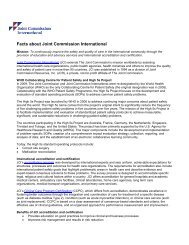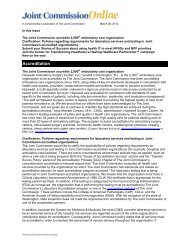Health Care at the Crossroads: Strategies for ... - Joint Commission
Health Care at the Crossroads: Strategies for ... - Joint Commission
Health Care at the Crossroads: Strategies for ... - Joint Commission
You also want an ePaper? Increase the reach of your titles
YUMPU automatically turns print PDFs into web optimized ePapers that Google loves.
<strong>Health</strong> <strong>Care</strong> <strong>at</strong> <strong>the</strong> <strong>Crossroads</strong>: Str<strong>at</strong>egies <strong>for</strong> Narrowing <strong>the</strong> Organ Don<strong>at</strong>ion Gap and Protecting P<strong>at</strong>ients<br />
Beyond <strong>the</strong>ir roles in preventive screening and<br />
addiction management, managed care plans<br />
are <strong>the</strong> primary providers of, or access points<br />
to, disease management programs. Currently,<br />
92 percent of priv<strong>at</strong>e health plans and 81 percent<br />
of Medicaid-only plans oper<strong>at</strong>e two or<br />
more disease management programs. 129 Most<br />
commonly, disease management programs<br />
provide support to p<strong>at</strong>ients with diabetes,<br />
asthma, coronary artery disease, congestive<br />
heart failure and high-risk pregnancy. 130 In<br />
addition, Medicare is in <strong>the</strong> process of initi<strong>at</strong>ing<br />
disease management demonstr<strong>at</strong>ion<br />
projects <strong>for</strong> congestive heart failure, diabetes,<br />
arthritis, hypertension, cancer, stroke, chronic<br />
obstructive pulmonary disease, hyperlipidemia,<br />
end-stage renal disease, and liver<br />
failure. 131<br />
Finally, while modern medicine has made<br />
gre<strong>at</strong> strides in preventing, tre<strong>at</strong>ing and containing<br />
<strong>the</strong> dire consequences of many diseases,<br />
access to such health care interventions<br />
and even <strong>the</strong> most basic of primary care, is a<br />
continuing challenge <strong>for</strong> <strong>the</strong> 43 million currently<br />
uninsured individuals and <strong>the</strong> millions<br />
of o<strong>the</strong>rs expected to join <strong>the</strong>ir ranks in <strong>the</strong><br />
coming years. 132<br />
INTO THE FUTURE<br />
Once p<strong>at</strong>ients receive <strong>the</strong>ir live-saving<br />
transplants <strong>the</strong>y often face new health risks.<br />
Immunosuppressive drug <strong>the</strong>rapy is hard on<br />
<strong>the</strong> body. In fact, from seven to 20 percent of<br />
non-renal transplant p<strong>at</strong>ients experience<br />
chronic renal failure within five years of <strong>the</strong>ir<br />
transplants. 133 Studies have also shown a<br />
higher risk of post-transplant malignancy rel<strong>at</strong>ed<br />
to immunosuppression. 134 Continued<br />
ef<strong>for</strong>ts to improve immunosuppressive drugs<br />
in <strong>the</strong> short term to reduce undesirable side<br />
effects and adverse outcomes are warranted.<br />
Over <strong>the</strong> long term, new and emerging science<br />
and technologies offer <strong>the</strong> potential to allevi<strong>at</strong>e<br />
<strong>the</strong> problems of graft rejection and failure,<br />
elimin<strong>at</strong>e <strong>the</strong> risks born from immunosuppressive<br />
<strong>the</strong>rapy, and even cre<strong>at</strong>e altern<strong>at</strong>ive<br />
approaches to closing <strong>the</strong> organ don<strong>at</strong>ion gap.<br />
PRIMARY CARE INTERVENTIONS AND DISEASE MANAGEMENT PROGRAMS THAT CURE,<br />
SLOW OR CONTAIN THE PROGRESSION OF DISEASES TO ORGAN FAILURE NEED<br />
TO BE VIGOROUSLY PURSUED.<br />
34


